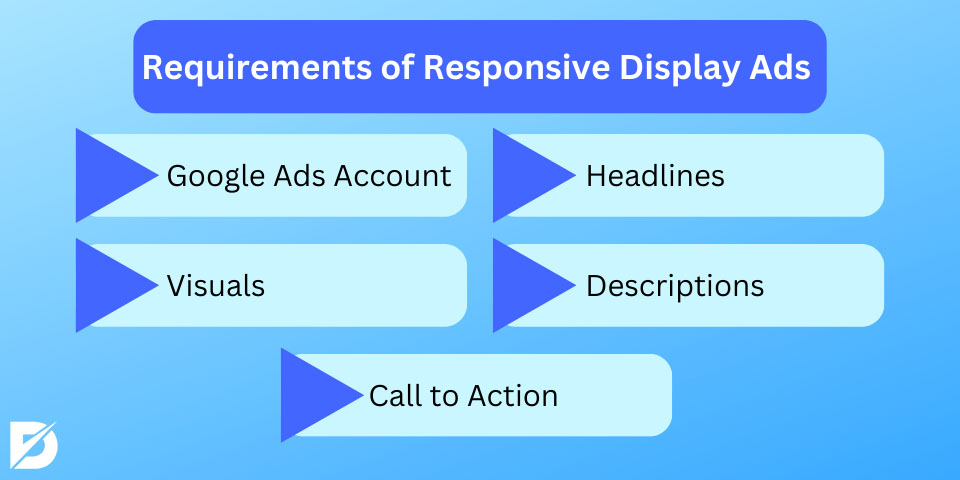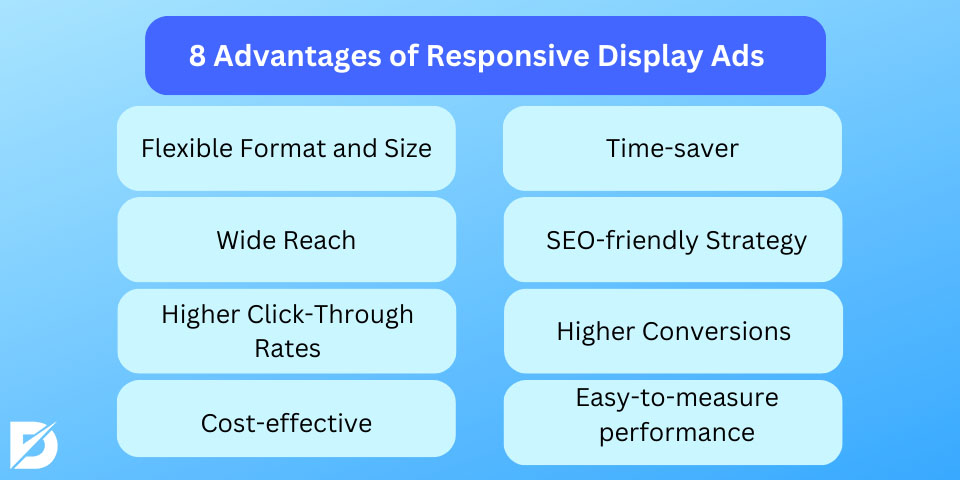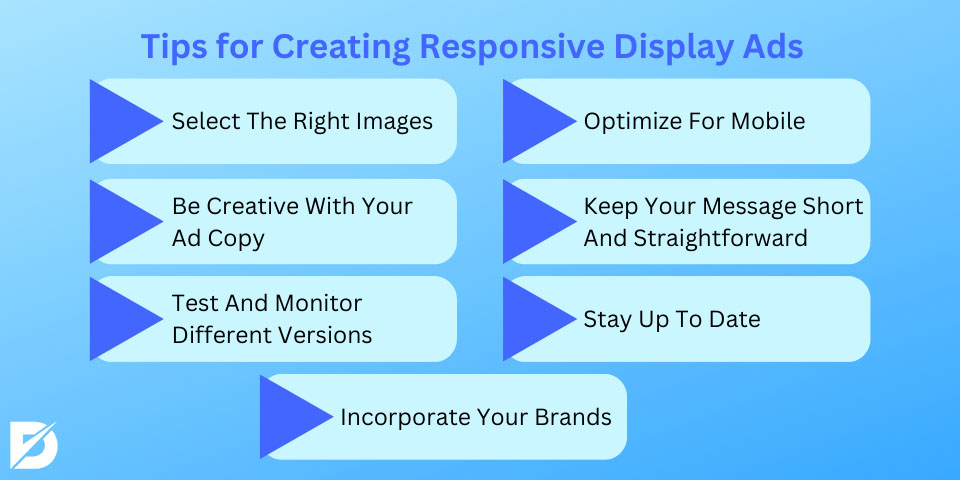Display ads play an important role in digital marketing. They can be a powerful strategy for your brand to connect with your target audience. These ads are effective in generating brand recognition by reaching a wider audience. At this point, your display ads should be responsive to reach people most likely to be interested in the advertised product or service. This is where responsive ads come into play. We would like to dive into this valuable topic in today’s guide. First, we’ll briefly introduce what these ads are. Second, we’ll list their main characteristics. Third, we’ll answer the question, “What’s provided by Responsive Display Ads?” list eight benefits. At the end of the guide, you can find the steps and tips to create an effective, responsive ad on Google Ads. Let’s dive in!
What Are Responsive Display Ads?
Responsive Display Ads are a dynamic and adaptive form of display advertising that can adjust their size, format, and appearance to fit the available ad space on the screen. Responsive ads are more adaptable to various devices, leading to better results, higher engagement, and performance. This ad strategy uses machine learning to optimize the ad creative and placement, allowing your brand to attract the right audience and achieve your marketing goals efficiently.
Before we move on to the eight benefits of responsive ads, we want to answer this critical question in your mind: “How do Responsive Display Ads benefit from automation?” The answer is simple to understand. You upload various elements, such as images, videos, headlines, or videos, into Google Ads while creating a responsive ad. In this case, Google employs a machine learning algorithm to analyze your advertisement performance history and, in return, make smart predictions. Based on these predictions, Google’s algorithm identifies the best combination of elements to display in each ad slot to achieve optimal ad performance. That’s it! You can get support from an expert for Google Ads management to achieve better ad campaign performance with a lower budget.
What’s A Characteristic of Responsive Display Ads
To create efficient Responsive Display Ads, there are some requirements you should keep in mind.

Google Ads Account
First things first. To upload your important assets, it is necessary to first sign in to your Google Ads account. You can easily create an account if you still need to.
Visuals
It is vital to prioritize using high-quality and attention-grabbing photos in your ads. These play a critical role because your ads will be displayed to users while they are engaged in other online activities. Therefore, your images should be visually compelling enough to capture the attention of your target audience.
You can upload up to 15 images, which should be of the highest quality possible. Google requires two different image sizes for Responsive Display Ads: landscape (minimum size 600 x 314 pixels) and square (minimum size 300 x 300 pixels). It’s essential to have images in various sizes to ensure your ad looks good across different devices and ad placements.
You can also upload up to 5 logos. Providing landscape and square images with a minimum size of 512 x 128 pixels and 128 x 128 pixels respectively, is recommended. If you don’t upload your logo, Google Ads will automatically create a logo, which may be the first letter of your brand name.
Google permits up to five videos to be included in a single ad, but they must be hosted on YouTube and be no longer than 30 seconds.
Headlines
When creating Responsive Display Ads, it’s essential to include ad copy in addition to image assets. You can create up to five headlines with a limit of 30 characters each, although only one headline will be displayed with each ad. Google will match your headlines with different images and descriptions to find the most effective combinations. By testing and evaluating the results, Google will automatically determine the most successful headlines for your ads, requiring minimal effort from you.
Descriptions
When creating your ad, the description section offers an excellent chance to highlight what sets your business apart from the competition, with a character limit of up to 90. It’s essential to make the most of this opportunity by including engaging and distinctive language that captures the attention of your target audience.
Call to Action
Don’t forget to add a call to action. In this case, consider including a clear and concise call to action at the end of your description. For instance, “Buy Now,” “Join Now,” “Contact Us,” “Show Now,” and “Apply Now” are some well-known examples you can use.
8 Advantages of Responsive Display Ads
Once we’ve understood responsive ads, a new question arises: “What’s an advantage of Responsive Display Ads?” Luckily, we do not have a single answer to this question. Here are the significant advantages of using this type of ad in your marketing strategy:

Flexible Format and Size
The format and size of responsive ads can be easily customized to fit different ad spaces across various websites. This flexibility in customization is a crucial advantage of these ads. This is because they can automatically adjust to fit their ad space without additional manual effort.
Wide Reach
Responsive ads can adjust to different sizes and shapes of ad spaces to maximize their visibility. By adjusting to various ad spaces, Responsive Display Ads can expand their audience across devices like desktops, tablets, and mobile phones.
Time-saver
These ads are designed to be flexible with automatic optimization and a wide range of ad space compatibility. So, you can save time on the design and don’t need to manually create multiple versions of the same ad. Google Ads can automatically generate different ad combinations based on its algorithm to optimize results. You will have time to focus on other aspects of your marketing strategy.
SEO-friendly Strategy
While there is no direct relationship between SEO and Responsive Display Ads, they can indirectly affect each other. These ads allow you to drive website traffic and create brand awareness by reaching a wider audience. Besides, these ads create a better visitor experience as they can adjust their size and shape to fit any device and browser.
Higher Click-Through Rates
Unlike pop-ups, these ads are less intrusive and allow users to interact with the content without interruption. Moreover, responsive ads leverage the power of machine learning to deliver personalized ads to each user based on their interests and behavior. This approach can increase the ad’s relevance and improve its click-through rate.
Higher Conversions
Responsive Display Ads can significantly enhance the visibility and effectiveness of your ads in terms of driving conversions. These ads offer a rich array of multimedia content, such as images, videos, and animations, which can significantly enhance their visual appeal and captivate the attention of potential audiences. Moreover, these ads can effectively engage your audience longer, providing more opportunities to showcase your products or services.
Cost-effective
Since these ads can automatically adjust different ad spaces, you don’t need to create multiple ad versions for different sizes. Besides, they can deliver a higher ROI than traditional display ads, thanks to their optimized creative and targeting capabilities.
Easy-to-measure performance
With Responsive Display Ads, measuring performance with Google Ads reporting tools is effortless. These tools allow you to easily track key metrics like clicks, impressions, and conversions. You can make quick adjustments and data-driven decisions to optimize your ad campaigns for better performance by monitoring the metrics. Google Ads also reports ratings and suggests improvements to strengthen the ad.
Responsive Display Ads vs. Traditional Display Ads
The impact of traditional display advertising is diminishing as consumers become increasingly skilled at avoiding ads. Unlike traditional ads, which can interrupt the user experience and disrupt the flow of content, Google Responsive Display Ads blend seamlessly into the site or app’s content. So, these ads provide value to both the advertiser and the audience. So, it’s true that responsive ads offer a distinct advantage over traditional ads. This is because they do not disrupt the browsing experience but rather provide value to the audience by presenting relevant content that aligns with their interests. For brands, this approach can lead to increased engagement, higher click-through rates, and, ultimately, more conversions.
Another key advantage is that responsive ads are often more relevant to the user. This is because these ads can be targeted based on the user’s browsing history or location, allowing for a more personalized advertising experience. So, Responsive Display Ads can also be used to retarget your target audience.
How to Create a Responsive Display Ads on Google Ads
To create responsive display advertisements, here are the steps you can follow
- Sign in to your Google Ads account
- From the navigation menu, click on “All Campaigns.”
- Choose “Display Campaigns” and select the campaign you want to create a responsive ad for.
- Click “Ads & Extensions” and then select “Ads.”
- Click the plus sign (+) and select “Responsive Display Ads.”
- Choose the ad group you want to add the ad to.
- Upload your images or add a video using the plus sign (+) video button.
- Add your business name, URL, headlines, and descriptions.
- Review the ad sizes and formats to ensure they match your campaign objectives.
- Preview your ad to check for any mistakes or discrepancies, then save it to publish.
Tips for Creating Responsive Display Ads
- Select The Right Images: Use attractive, clear pictures that relate to your brand and message. Ensure the images are adjusted to fit the ad’s size and load fast.
- Be Creative With Your Ad Copy: Write interesting and convincing ad messages that connect with your intended audience. Try to convey the exclusive benefits of your product or service in a way that distinguishes you from similar offerings.
- Test And Monitor Different Versions: Make several versions of your flexible ads and experiment to determine which ones work best. This can assist you in improving your ad campaigns to achieve the most significant impact.

- Optimize For Mobile: Ensure that your flexible ads are suitable for mobile devices since many people access the internet through their mobiles. Ensure your ad loads fast and is simple to interact with on small screens. You can test your website with Dopinger’s Mobile-Friendly Test Tool.
- Keep Your Message Short And Straightforward: Use powerful titles and directions that catch the user’s attention and encourage them to click on your website. You can use a compelling call to action, such as “Buy Now” or “Let Us Call You.”
- Stay Up To Date: It’s crucial to stay updated with the latest trends and techniques for Responsive Display Ads since they’re constantly changing.
- Incorporate Your Brands: Include your brand’s visual style in your flexible ads to promote brand familiarity and reliability with your audience. Use consistent colors, images, and fonts to build a memorable brand identity.
When Should We Use An Responsive Display Ads?
Now that we’ve got a comprehensive idea of responsive ads. The last question is, “When should we use a responsive ad?” The correct answer varies based on your needs and preferences. For instance, responsive ads are the best choice to run across multiple devices, including laptops, tablets, desktops, and smartphones. Or, when you want to optimize your ad strategies for performance, responsive ads allow you to do it best. This is because machine learning used by Responsive Display Ads helps you test different combinations of images, descriptions, and headlines to identify the best-performing ad. In return, you will be able to get higher CTR and conversion rates.
Responsive ads are also the best option if you want to spend less time and resources while reaching a larger audience. Since ads are automatically sized and shaped to the screen, you only need to create a few images, logos, and descriptions: Google will take care of the rest.
Final Thoughts
Customizing ad format and size while optimizing appearance for various ad spaces on different websites is a crucial advantage of responsive ads. This means you can design one advertisement that fits multiple platforms and devices without requiring frequent modifications and revisions. In today’s guide, we’ve tried to answer “What’s provided by Responsive Display Ads?” The significant benefits are creating ads in flexible sizes and formats, reaching a wider audience, and increasing higher CTR and conversions. Besides, unlike traditional ads, responsive ads integrate with users while engaging in other online activities.
Frequently Asked Questions About
Yes, you can. However, it is essential to remember that the video should be on YouTube and have a duration of no more than 30 seconds.
The answer lies in responsive ads. They are the best choice to save time, reach a wider audience, increase conversions, and have a limited ad budget!
Responsive Display Ads can automatically modify their size, format, and appearance to fit various ad spaces. Conversely, Display Ads are produced in predetermined ad sizes and formats and cannot adapt to suit different ad spaces.
Google advises the usage of images that are of high quality and have a minimum resolution of 600 x 314 pixels.
There exist multiple benefits to using Responsive Display Ads. For example, the ability to display ads on numerous websites increases the potential audience that can be reached through a single ad campaign.





No comments to show.